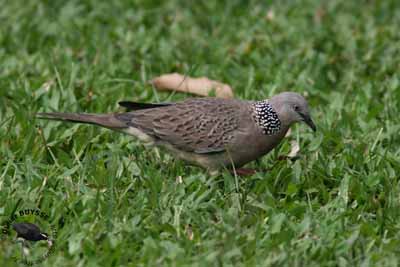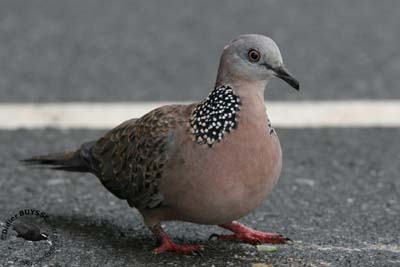
Spotted Dove
Streptopelia chinensis
Columbiforme Order – Columbidae Family
BIOMETRICS:
Length : 30 à 33 cm
Wingspan : 43 à 48 cm
Weight : 160 g
LONGEVITY: Up to 8 years
DESCRIPTION:
Spotted Dove is a stocky bird with square-tipped tail. Adult has pale brown upperparts, streaked with dark buff. Breast is pale pinkish-grey. Belly is white. Long tail is brown with white tips. When in flight, we can see the blackish flight feathers.
Head is pale, pinkish to greyish. We can see a black patch finely spotted with white on the rear neck, between nape and upper back.
Bill is blackish. Eyes are reddish-brown. Legs and feet are red.
Both sexes are similar.
Juvenile has duller plumage and lacks the rear neck patch.
PROTECTION / THREATS / STATUS:
Spotted Dove is preyed upon by humans. Predators are corvids, birds of prey, cats and other carnivores. This species is vulnerable to habitat loss with human developments, agricultural herbicides and trapping for pet trade in some countries.
Fr: Tourterelle tigrine
All : Perlhalstaube
Esp : Tórtola Moteada
Ital : Tortora macchiata
Nd : Pareltortel
Russe : Китайская горлица
Sd : Pärlhalsduva
Photos de Didier Buysse
Son site :
Vision d’Oiseaux
Texte de Nicole Bouglouan
Sources :
HANDBOOK OF THE BIRDS OF THE WORLD vol 4 by Josep del Hoyo-Andrew Elliott-Jordi Sargatal - Lynx Edicions - ISBN: 8487334229
PIGEONS AND DOVES by David Gibbs, Eustace Barnes and John Cox - Pica Press Sussex - ISBN: 1873403607
What Bird-The ultimate Bird Guide (Mitchell Waite)
Wikipedia (Wikipedia, The Free Encyclopedia)
Birds in backyards (Birds Australia and Australian Museum)
All About Birds (Cornell Lab of Ornithology)

VOICE: SOUNDS BY XENO-CANTO
Spotted Dove’s call is a sonorous cooing “kou-kour-kour”, a low “coo-croo-coo”, a soft “te-croo-croo”, and three notes “coo-coo-croo” with emphasis at the end.
HABITAT:
Spotted Dove is often near human habitations. It frequents countries to mountains, villages, suburban areas and gardens. It also may be found in open woodlands and farmlands, and doesn’t frequent dense forests.
RANGE:
Spotted Dove has a wide distribution. It is native from southern Asia, from India and Sri Lanka, east to southern China and SW Asia.
This species has been introduced in the United States, in California area (Los Angeles), but also in Indonesia, Australia and New Zealand. The species range is expanding in all areas.
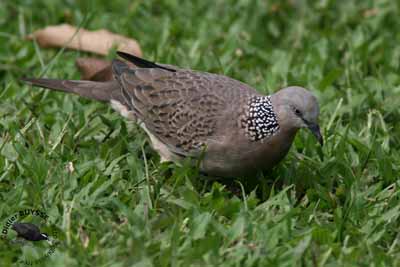
BEHAVIOUR:
Spotted Dove feeds mainly on seeds and it forages through vegetation or on the ground. It forages singly or in pairs, sometimes in small groups if there is a good food site.
During breeding season, some displays are observed, such as Bowing displays, and Flight displays.
Bowing display shows male and female close to each other, perching or walking on the ground or a branch, while male bows the head, calling with each bow. This display allows exposing the black and white patch of rear neck.
Flight display of the male consists of steep upwards flight from a perch, often with clapping wing beats, and then, a long downwards glide in circular dive, with wings and tail widely spread.
We can see other varied displays such as preening and billing, typical of this family. Copulation follows bowing displays. They are monogamous.
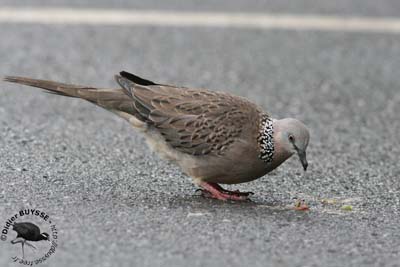
Pigeons and doves have some special feathers on their bodies, which disintegrate for producing a kind of powder, used for cleaning and lubricate the other feathers. These species have not well developed oil glands.
Other particularity of these species is the “pigeon milk”. It is crop milk produced by special glands in the crop, secreting a thick milky substance during nesting season. Chicks are fed with this crop milk, poking their bills into parents’ throats.
Spotted Dove doesn’t migrate, but performs some dispersion in order to colonise other suitable areas.
When disturbed, Spotted Dove rises swiftly and dashes for leafy cover.
FLIGHT:
Spotted Dove performs swift direct flight with rapid wing beats. While flying, the bird spreads its long tail and displays the white tips.
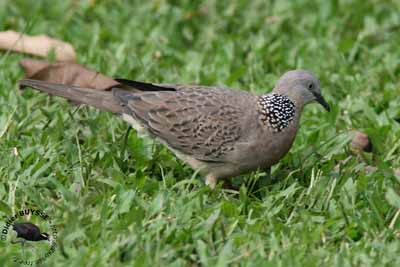
REPRODUCTION:
Spotted Dove breeds year round. Both adults build the nest in trees or bushes, near open areas.
Nest is a loose platform made with twigs, grasses and roots. The nest of this particular species is often less flimsy than that of other doves. It is situated at about 3 metres above the ground, but it may be built from 1 to 14 metres high.
Female lays one or two white slightly glossy eggs. Incubation lasts about 14 to 16 days, shared by both parents. Altricial chicks are sparsely covered with pale down. Parents brood and care for them continuously for the first week. Young are fed by both adults with crop milk for several days. Later, young are fed with soft matters such as regurgitated seeds.
Young fledge about two weeks after hatching, and parents immediately start a new clutch.
DIET:
Spotted Dove feeds mainly on seeds and grains. Dove drinks by sucking and doesn’t have to tilt the head back to swallow.
